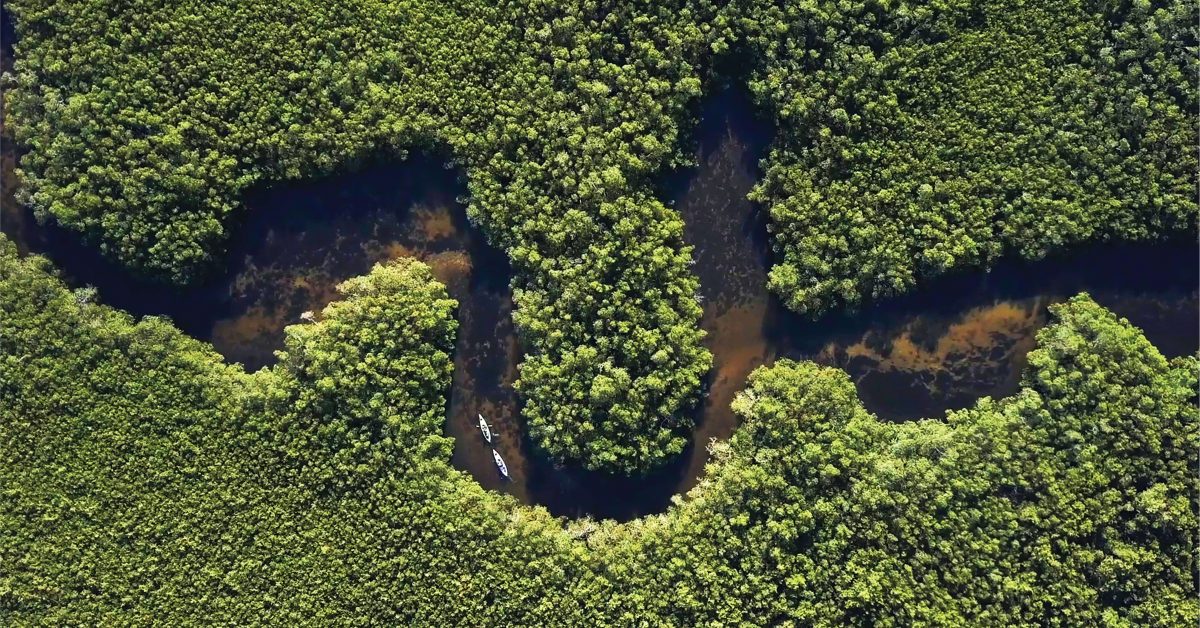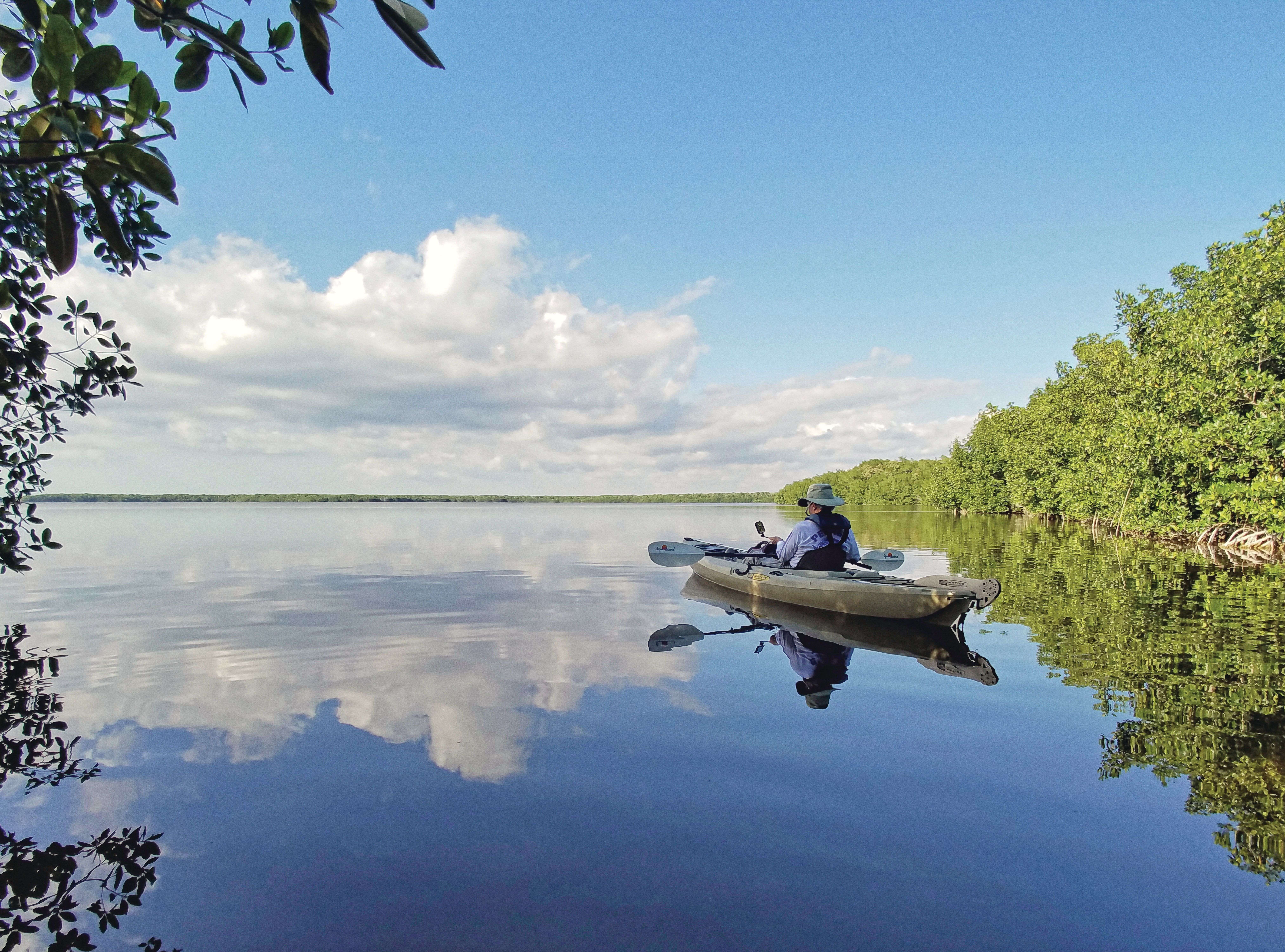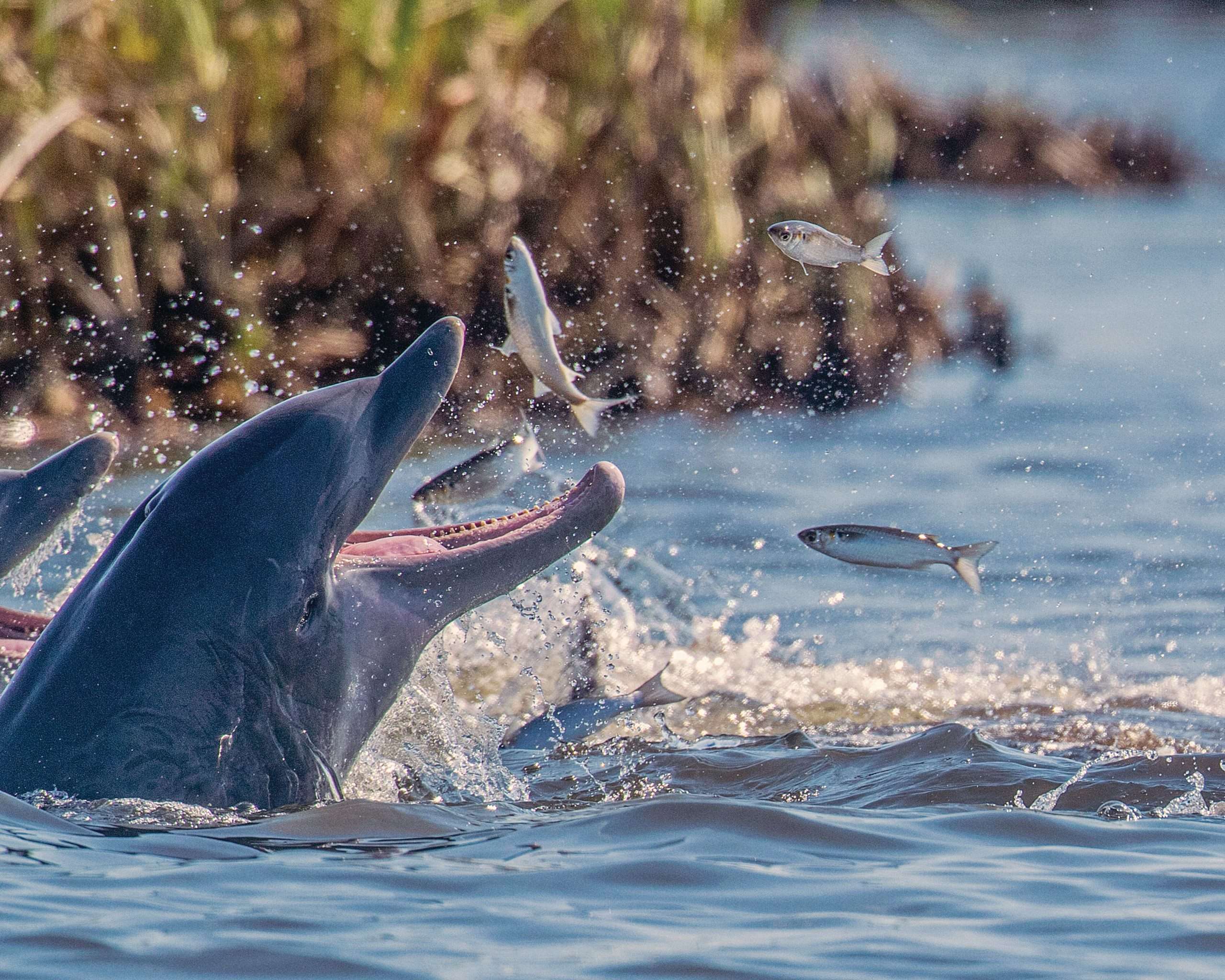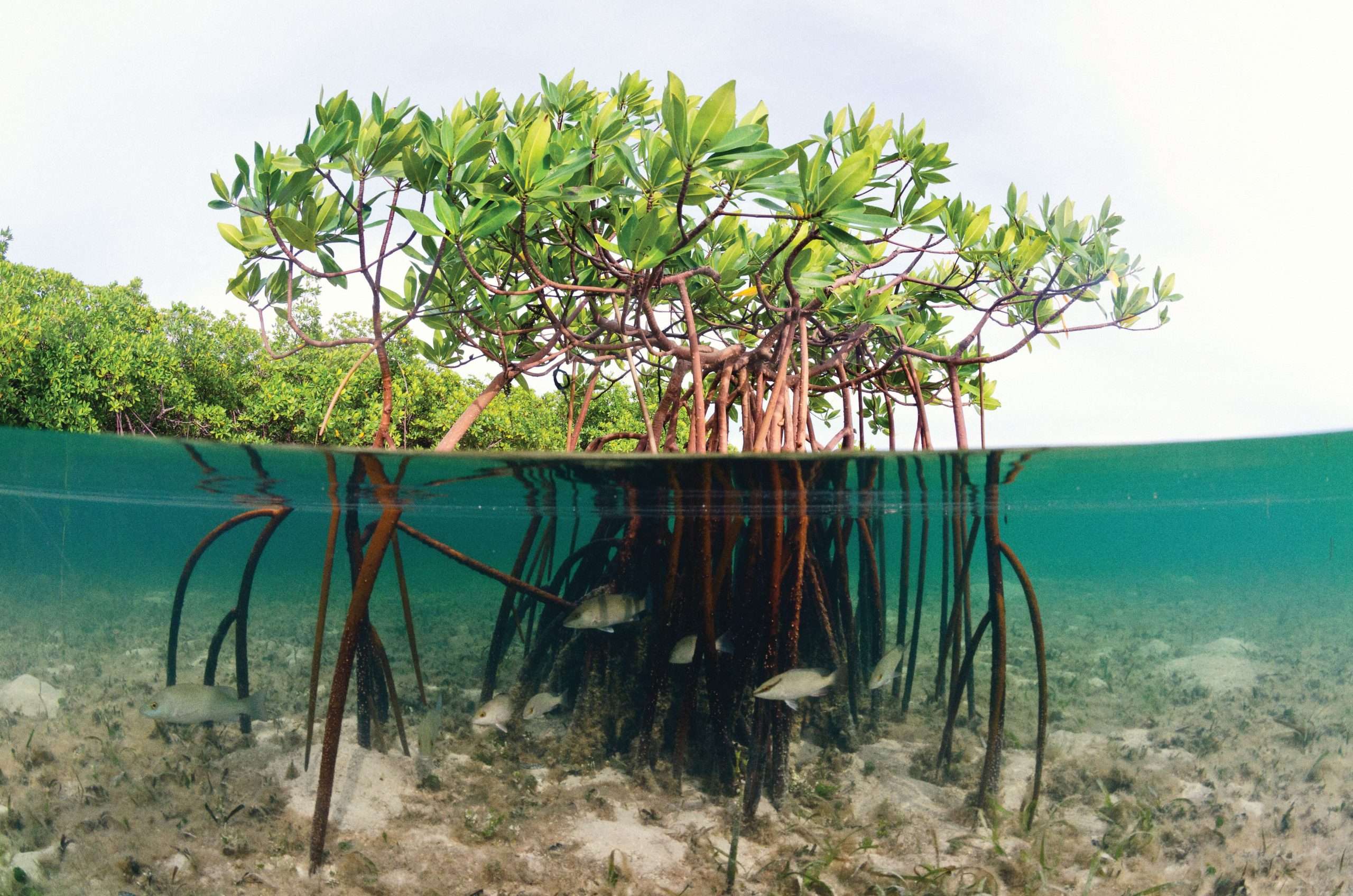Dead zone
On a cool Tuesday morning in the middle of December, fog sits heavy over San Marco Road, the 10-mile stretch of asphalt that connects Marco Island and Tamiami Trail. Healthy mangroves line the north side of the road, the section that borders Fruit Farm Creek. Their foliage is a dense green, thick and impenetrable. But on the south side of the highway, it’s a different story. The road has been preventing water flow between the two sections of wetlands for decades. Though mangroves are one of the most resilient plant species in Southwest Florida—they grow in saltwater, for Pete’s sake—they need flowing water to survive.
The morning fog adds an eerie stillness to the landscape. Tall snags of what once were black mangroves rise 20 and 30 feet in the air. They are dried out, gnarled and gray, stripped of bark, like upright pieces of driftwood. They stand in a thin layer of unmoving water that’s yellow and covered with a scrim of foam. Walk 100 yards east, where the water moves and the mangroves are alive, and the air is thick with vibrancy—the chirp of frogs, the smell of brackish water, the quick darts of herons and egrets. But in the 64 acres of mangrove die-off, there is no noise. No movement. No smells beyond the fetid water. The effect is nuclear in its devastation: This is a dead place. Or, more accurately, a dying place.
But it won’t be for long.
In September 2021, a team from the Rookery Bay National Estuarine Research Reserve broke ground on one of the largest mangrove restoration projects in the state of Florida. The Fruit Farm Creek Mangrove Restoration Project will install three 54-inch-diameter culverts beneath San Marco Road, connecting the two sections of wetlands and returning sheet flow to the mangrove forest. The project is budgeted to cost $1.4 million, a price many insist is worth it.
Mangroves are essential to Southwest Florida—not just for the health of the ecology, but as a barrier to storms. Biologists, marine engineers and developers all know this. The problems arise at the intersection of these competing interests. Even as we create jobs for builders, contractors and tradesmen, even as we add more property value to the tax roll, even as we attract visitors and new residents who funnel millions of dollars into the state’s coffers, we risk sacrificing one of the most important parts of the Gulfshore.
Protecting the ecosystem
Imagine the green propagules of mangroves, thick as a finger, long as a pencil, some with green leaves already sprouting from their tips. They drift along currents in the Gulf of Mexico and make their way to Southwest Florida’s coast, tossed along the shore with the seashells, stretched out like stacks of cordwood. Some few will take root, landing just right, but most disappear into the debris along the shoreline.
For millions of years, mangroves have been doing exactly this—propagating via these stick-like envoys that follow ocean currents to new homes. Scientists suspect that mangroves first arrived along the Gulf coast somewhere between 66 and 23 million years ago, during the period of time that stretched between the upper Cretaceous and lower Miocene periods. Early mangroves originated in the region that encompasses today’s India and Southeast Asia. The first propagules dropped into the Bay of Bengal before traveling westward toward the horn of Africa, then around the southern tip of the continent, before drifting into the Atlantic Ocean. Eventually they moved northward into the Caribbean Sea and the Gulf of Mexico, where they took root in the warm coastal regions of the Americas.
There, they flourished. Unlike most plants, mangroves thrive in salty environments. They secrete excess salt through their leaves, allowing the uptake of water needed for survival. In coastal environments where even hardy natives are often stunted, the mangrove prospers.
Above water, mangroves provide essential nesting and roosting grounds for coastal birds. Pelicans, herons, egrets and magnificent frigatebirds build rookeries in their branches. The trees serve as places to raise young and hide from predators.
Below water, mangroves provide an essential habitat for fish, crustaceans and shellfish. They serve as nurseries for small fry, sheltering young fish as they grow. Ask any weekend fisherman about the best spots for snook, red snapper and sheepshead, and they’ll tell you, “Up against the mangroves.” Without mangroves, Southwest Florida’s recreational and commercial fishing industries would be decimated.
The original hurricane protection
Consider this: Mangroves serve as an essential barrier during coastal storms. According to a recent collaborative report between The Nature Conservancy and insurance professionals, mangroves prevented $1.5 billion of property damage during Hurricane Irma. In Collier County, they reduced annual flood risk to the properties that sit behind them by 25.5%. The thick branches, intermingled root systems and dense foliation all act as a first line of defense against winds and storm surge. Take out mangroves and the coastline is left bare, exposed to the elements, with no protection from the rising tides and fierce winds of the tropical storms that buffer our region.
“The data is unequivocal,” says Dr. Win Everham, a professor in the department of ecology and environmental studies at Florida Gulf Coast University. “If you protect mangroves, you protect yourself.” An environmental scientist in this region for the past 25 years, Everham has led studies on mangroves in Estero Bay. “If you get rid of vegetation on the coast, there’s a price to be paid for it in terms of storms,” he says. “Take out mangroves, and you’re going to suffer from storm surge. That’s not an opinion. That’s just the way ecology works.”
A complicated legal matter
Everyone seems to agree that mangroves are essential to the health of the Southwest Florida ecosystem. They protect local fisheries and birds. They even buffer the coast from devastating hurricanes. So, why is it so hard to protect them?
The answer, as is so often the case in Southwest Florida, is development. Visitors and new residents love the nature of this region. They adore the water, the wildlife, the green spaces that define the Gulfshore. But they also want a waterfront home with a view. For years, the state of Florida has tried to balance this demand for unfettered coastal access with the need to protect our state’s fragile marine ecosystems.
In 1996, the Florida Legislature passed the Mangrove Trimming and Preservation Act, which was intended to simplify years of snarled and opaque regulations surrounding mangroves. The act stated that mangrove trees could not be trimmed, removed or otherwise disturbed without a permit from the Florida Department of Environmental Protection. The act also prevents the use of any kind of herbicide or other chemical to defoliate mangrove trees. Today, the FDEP is in charge of both creating policies around mangroves and enforcing protective measures.
A delicate balance
With nearly half a million acres of mangroves along Florida’s coastline and an ever-increasing hunger for coastal property, a compromise is needed between the demands of a healthy ecology and the appetites of a growing economy. Hans Wilson, founder of Fort Myers-based marine engineering firm Hans Wilson & Associates, said this is entirely possible. “People think that we’re destroying mangroves left and right in some kind of Western free-for-all,” Wilson says. “That’s not the case.” In actuality, he believes, most people are exercising the proper permitting process.
“People come from other places and they’re looking for their image of the perfect Florida environment—a beautiful green sodded lawn that runs down to a vertical concrete seawall and then open water,” he says. “In many cases, they have very little knowledge or respect for the natural systems that constitute Southwest Florida.” It’s the job of those in the private sector—builders, architects and marine engineers such as Wilson—to protect the fragile ecosystem. Wilson firmly believes that people can accomplish their design objectives while using the natural environment as a partner.
Take as an example a single-family home on a site with mangroves along the shoreline. “Some people come in with the mindset that they want to nuke the mangroves and put in a vertical seawall,” Wilson explains. But his firm presents better options, such as raising the elevation of the house. This keeps the mangroves in place and still allows for a view of the water.
Another possibility is to trim a window in the mangroves in accordance with the state mangrove trimming rules, creating a view for the homeowner while allowing the mangrove system to stay in place. “You keep the mangroves producing detritus, which goes into the water for crabs and fish to use as a food source,” Wilson says. “And you also allow for oysters and barnacles to remain attached to the mangrove roots, an important component of keeping the water clean, which is what attracts many people to this community in the first place.”
A mitigating option
But sometimes it’s not possible to avoid cutting down mangroves, as for example when a lot is oddly shaped. In this case, marine engineers and builders turn to the Little Pine Island Mitigation Bank, a 4,670-acre island owned by the State of Florida and situated within the Charlotte Harbor Aquatic Preserve. A joint public-private partnership, the island is a source of credits used to offset unavoidable impacts to wetlands in Lee, Collier, Charlotte and Sarasota counties.
The mitigation bank project was launched in 1997 with the aim of restoring Little Pine Island, whose wetlands had been destroyed by mosquito ditches in the 1960s. Money raised through mitigation credits allowed the island to be restored to its original condition. The project was so successful that Little Pine Island is now part of the Great Calusa Blueway, open to birders, hikers and outdoor enthusiasts. Money from current mitigation credits is deposited into a trust fund, which pays for the ongoing maintenance of the island.
It’s not an ideal solution, of course. In a perfect world, development and the environment would never collide. But this is the real world where the State of Florida, local builders and property owners are—for the most part—doing the best they can. “The reality is that most people in our community who exercise the mangrove permitting process care very much,” says Wilson. “Not all of them, but the good ones do. And the ones who don’t reflect this mindset? They don’t stay in business very long.”
Mangroves by the numbers
$7,100: The economic value generated by each acre of mangroves for fisheries, watchable wildlife and the protection of infrastructure, according to the Florida Fish and Wildlife Conservation Commission.
$1.5 billion: Amount in property damages avoided during Hurricane Irma because of mangroves, according to a study from the Nature Conservancy.
25.5%: In Collier County, mangroves reduced annual flood risk by 25.5% to the properties behind them, according to the collaborative report “Valuing the Flood Risk Reduction Benefits of Florida’s Mangroves.”
Types of mangroves
The red mangrove is the most widely encountered mangrove in our area. It grows along the edge of brackish water, often bordering the canals that boaters and kayakers pass through. It’s recognizable by its red prop-roots, the tangled, knob-kneed roots that appear at low tide.
Black mangroves sit away from the water on slightly higher terrain than red mangroves. Their most notable features are pneumatophores, black finger-like projections that rise from the soil around the tree trunk. Florida old-timers call them “dead man’s fingers.”
White mangroves are found at the highest elevations near the coast. Unlike red mangroves with their prop roots and black mangroves with their pneumatophores, white mangroves have no identifiable aerial root systems. The leaves are pale green and silver in color, with two glands at the base of each leaf for secreting excess salt.








